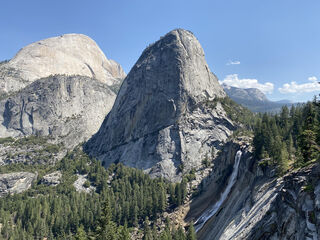Health
Improve Mind-Body Health and Well-Being Through Time in Nature
The health and wellness benefits of spending time in nature are wide and deep.
Posted August 15, 2021 Reviewed by Vanessa Lancaster
Key points
- An increasing body of scientific research demonstrates the breadth of benefits of contact with nature on human health and well-being.
- Life's challenges, exacerbated by the Covid-19 pandemic, mean more and more people are vulnerable to chronic stress, anxiety, and depression.
- Hiking in wilderness areas is a powerful metaphor for the process of negotiating uncertainty and the accompanying self-doubt.
- Hiking is an activity that necessitates and promotes mindfulness, being present with and moving through ambiguity that can be dysregulating.

Climb the mountains and get their good tidings. Nature’s peace will flow into you as sunshine flows into trees. ~ John Muir
The complexities and demands of life in the 21st century, exacerbated by the uncertainties of the coronavirus pandemic, seem to render more and more people vulnerable to chronic stress, anxiety, and depression, in addition to a range of health problems specific to Covid-19. Caught up in and carried away by the current of this river of challenges, they drift further away from conscious contact with present moment awareness and, in turn, from the experience of any semblance of feeling centered, anchored, or grounded.
Since long before the emergence of Covid human beings have become increasingly disconnected from nature, especially in the US. Surveys indicate that Americans spend over 90% of their time indoors–most in buildings, with a smaller portion in vehicles.
Yet, an unanticipated effect of the isolation and withdrawal required by quarantining during the height of the pandemic has been the substantial increase (sometimes to the point of straining capacity) in the desire of people to spend time in nature, notably America’s national parks.
An increasing body of scientific research demonstrates the breadth of benefits of contact with nature—ranging from urban parks to wilderness areas—on human health and well-being. These include but are far from limited to:
- Reduced stress
- Improved sleep
- Decreased anxiety
- Decreased depression
- Improvement in ADD/DHD symptoms
- Greater contentment and happiness
- Increased prosocial behavior
- Lowered blood pressure
- Improved pain control
- Improved immune system functioning
When we go for a walk or hike, the heart pumps faster, circulating more blood and oxygen not just to the muscles but to all the organs—including the brain. Walking regularly also promotes new neural connections.
Moreover, these activities are a protective factor against the usual atrophying of brain matter that comes with age, increases the volume of the hippocampus (a brain region crucial for memory), and elevates molecules' levels that stimulate the growth of new neurons and transmit messages between them.
In addition to all of these health-enhancing advantages, hiking in wilderness areas is a powerful metaphor for the process of negotiating uncertainty and accompanying self-doubt that characterizes finding one’s way through the mental-emotional-spiritual wilderness of these unsettled and highly variable times.
Hiking is an activity that necessitates and promotes mindfulness. Following a trail in the mountains, forest, or desert provides valuable opportunities to learn and practice skills that involve being present with and moving through uncertainty and ambiguity that can easily be emotionally dysregulating—provoking anxiety, self-doubt, frustration, and/or fear.
When the trail is wide and well defined, we can see what lies ahead for a considerable distance. It is impossible to know what’s around the next bend when the route is fraught with twists and turns. Sometimes a trail starts easy to identify and follow. Still, later, the very same trail becomes difficult to discern, seeming to disappear altogether or present several potential—and equally plausible—options.
Under such circumstances, it’s best to pause and become still physically and mentally. When we become more mindful in observing and quieting the internal chatter that drives anxiety, frustration, and self-doubt, we’re able to pay closer and more attuned attention, locate the trail, and continue. Occasionally our assessment of where the trail picks up is mistaken, and we may have to backtrack to find the correct path.
Sometimes the terrain is nice and level, has mild uphills and downhills, and is easy to traverse. At other times it’s brutally steep, necessitating significant ascents and subsequent descents, making the trek arduous and wearying. The steep inclines are often slow, require tremendous energy, while steep downhills necessitate continuous adjustments to maintain balance. Sometimes, the trail is smooth and relatively free of obstacles, or it’s covered with large rocks or loose rock known as scree, tree roots, or deep sand, making it challenging to negotiate, and a misplaced step can lead to falls and injuries.
Some trails can seem routine and prosaic, their inherent beauty more commonplace and subtle, and we have to look harder and deeper to see it. Other trails traverse such remarkable landscapes that their beauty is immediate and instills a sense of awe.
From the perspective of an avid hiker, some days on the trail are a slog. My body is heavy and lethargic, and each step seems difficult. Progress is slow and halting as I plod forward, narrowing my focus to placing one foot in front of the other, literally taking everything one step at a time. Other days, my mind and body are in tune, and my spirit is open wide, synced with the wind caressing stands of Ponderosa Pines, Douglas Firs, and (above 9,000 feet in elevation in select areas of southern Nevada) Bristlecone Pines, along with the faces of granite, sandstone, and limestone rock formations.
Hiking in the wilderness necessitates careful and conscious preparation, as well as a tremendous amount of work. The tradeoff? Being able to see and experience wondrous, transcendent places—geographically and spiritually—that can open our hearts and are accessible in no other way.
Copyright 2021 Dan Mager, MSW
References
The National Human Activity Pattern Survey (NHAPS): a resource for assessing exposure to environmental pollutants.
Klepeis NE, Nelson WC, Ott WR, Robinson JP, Tsang AM, Switzer P, Behar JV, Hern SC, Engelmann WH, J Expo Anal Environ Epidemiol. 2001 May-Jun; 11(3):231-52. https://www.ncbi.nlm.nih.gov/pubmed/11477521/
Berto R. 2014. The role of nature in coping with psycho-physiological stress: A literature review on restorativeness. Behav Sci (Basel) 4(4):394–409, 10.3390/bs4040394.
Morita E, Imai M, Okawa M, Miyaura T, Miyazaki S. 2011. A before and after comparison of the effects of forest walking on the sleep of a community-based sample of people with sleep complaints. Biopsychosoc Med 5:13, PMID: 21999605, 10.1186/1751-0759-5-13.
Bratman GN, Hamilton JP, Daily GC. 2012. The impacts of nature experience on human cognitive function and mental health. Ann N Y Acad Sci 1249:118–136, PMID: 22320203, 10.1111/j.1749-6632.2011.06400.x.
Cohen-Cline H, Turkheimer E, Duncan GE. 2015. Access to green space, physical activity and mental health: a twin study. J Epidemiol Community Health 69(6):523–529, PMID: 25631858, 10.1136/jech-2014-204667.
Faber Taylor A, Kuo F. 2009. Children with attention deficits concentrate better after walk in the park. J Atten Disord 12(5):402–409, 10.1177/1087054708323000.
MacKerron G, Mourato S. 2013. Happiness is greater in natural environments. Global Environmental Change 23(5):992–1000, 10.1016/j.gloenvcha.2013.03.010.
Piff PK, Dietze P, Feinberg M, Stancato DM, Keltner D. 2015. Awe, the small self, and prosocial behavior. J Pers Soc Psychol 108(6):883–899, PMID: 25984788, 10.1037/pspi0000018.
Duncan M, Clarke N, Birch S, Tallis J, Hankey J, Bryant E, et al. 2014. The effect of green exercise on blood pressure, heart rate and mood state in primary school children. Int J Environ Res Public Health 11(4):3678–3688, 10.3390/ijerph110403678.
Han J-W, Choi H, Jeon Y-H, Yoon C-H, Woo J-M, Kim W. 2016. The effects of forest therapy on coping with chronic widespread pain: Physiological and psychological differences between participants in a forest therapy program and a control group. Int J Environ Res Public Health 13(3):255, 10.3390/ijerph13030255.
Li Q, Kawada T. 2011. Effect of forest environments on human natural killer (NK) activity. Int J Immunopathol Pharmacol 24(1suppl):39S–44S, PMID: 21329564.
Voss MW, Prakash RS, Erickson KI, Basak C, Chaddock L, Kim JS, Alves H, Heo S, Szabo AN, White SM, Wójcicki TR, Mailey EL, Gothe N, Olson EA, McAuley E, Kramer AF. Plasticity of brain networks in a randomized intervention trial of exercise training in older adults. Front Aging Neurosci. 2010 Aug 26;2:32. doi: 10.3389/fnagi.2010.00032. PMID: 20890449; PMCID: PMC2947936.
Erickson, K. I., Raji, C. A., Lopez, O. L., Becker, J. T., Rosano, C., Newman, A. B., Gach, H. M., Thompson, P. M., Ho, A. J., & Kuller, L. H. (2010). Physical activity predicts gray matter volume in late adulthood: the Cardiovascular Health Study. Neurology, 75(16), 1415–1422. https://doi.org/10.1212/WNL.0b013e3181f88359.
Kirk I. Erickson, Michelle W. Voss, Ruchika Shaurya Prakash, Chandramallika Basak, Amanda Szabo, Laura Chaddock, Jennifer S. Kim, Susie Heo, Heloisa Alves, Siobhan M. White, Thomas R. Wojcicki, Emily Mailey, Victoria J. Vieira, Stephen A. Martin, Brandt D. Pence, Jeffrey A. Woods, Edward McAuley, Arthur F. Kramer. Exercise training increases size of hippocampus and improves memory. Proceedings of the National Academy of Sciences Feb 2011, 108 (7) 3017-3022; DOI:10.1073/pnas.1015950108.
Segal SK, Cotman CW, Cahill LF. Exercise-induced noradrenergic activation enhances memory consolidation in both normal aging and patients with amnestic mild cognitive impairment. J Alzheimers Dis. 2012;32(4):1011-8. doi: 10.3233/JAD-2012-121078. PMID: 22914593; PMCID: PMC3951984.




